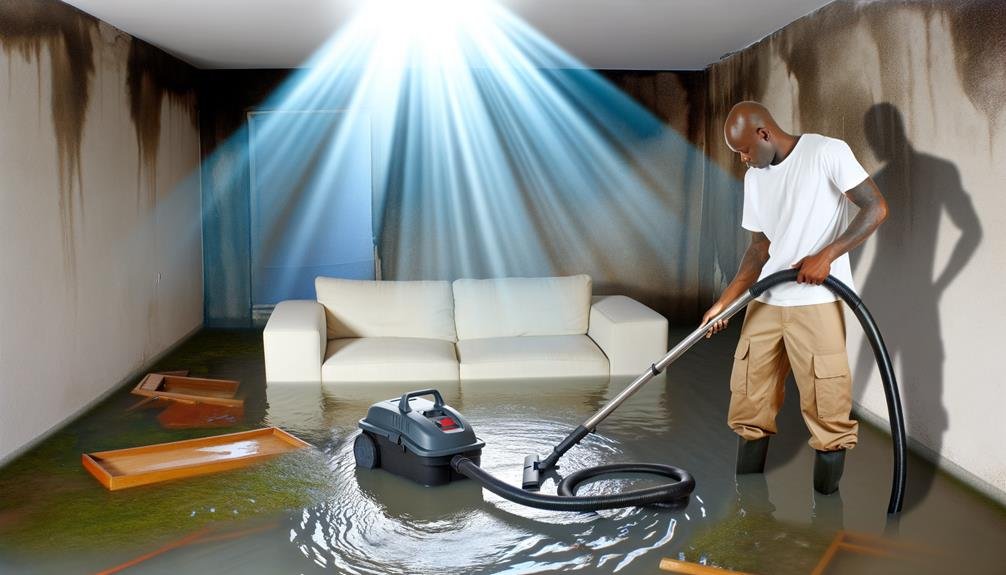When facing water damage in Atlanta, it's essential to act quickly to protect your home from further issues. Start by turning off utilities and removing standing water using wet/dry vacuums or pumps. Thoroughly dry affected areas with fans and dehumidifiers, as moisture control prevents mold growth. Assess the damage using moisture meters to guide necessary repairs. For significant issues, consider professional restoration services, which have specialized training and equipment. Finally, implement regular maintenance checks to prevent future damage and guarantee proper drainage. There's much more to investigate about safeguarding your home effectively.
Understanding Water Damage
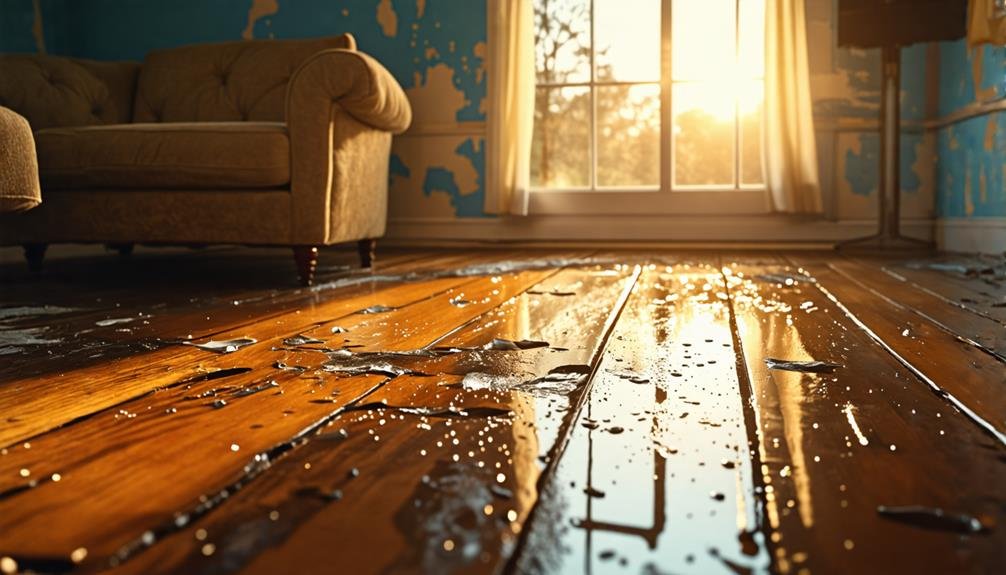
Water damage can occur from various sources, including leaks, floods, and burst pipes, and understanding its implications is fundamental for effective restoration. Familiarizing yourself with the different water damage types helps you assess the severity of the situation. There are typically three categories: clean water, gray water, and black water. Clean water comes from a clean source, like a burst pipe; gray water contains some contaminants, such as from dishwashers; while black water includes sewage and poses significant health risks.
Moisture control plays a critical role in preventing further damage and mold growth. Once you identify the type of water damage, it's crucial to address moisture levels immediately. High humidity can worsen the situation, allowing mold spores to thrive. You should monitor humidity levels and use dehumidifiers to maintain a safe environment.
Immediate Actions to Take
When faced with water damage, your first step is to turn off utilities to prevent electrical hazards. Next, remove any standing water as quickly as possible to minimize further damage. Taking these immediate actions can greatly reduce the impact of the water incident.
Turn Off Utilities
Turning off utilities is crucial to prevent further damage and guarantee safety during a water damage incident. Taking these immediate actions can help you control the situation effectively:
- Shut Off the Water Supply: Locate the main water shutoff valve and turn it off. This prevents any additional water from entering your home, which could worsen damage.
- Turn Off Electricity: If it's safe to do so, shut off your home's electricity at the breaker box. Water and electricity are a dangerous combination, so this safety precaution is critical.
- Disconnect Gas Supply: If you suspect gas lines may be affected, locate your gas shutoff valve and turn it off. This minimizes the risk of leaks or explosions.
Remove Standing Water
Removing standing water promptly is essential to minimize damage and prevent mold growth in your home. As soon as you've turned off your utilities, assess the situation and determine the source of the water. If it's safe to do so, begin the water extraction process. Use a wet/dry vacuum or a sump pump to remove standing water effectively.
If you're dealing with a significant amount of water, consider contacting professionals who specialize in water extraction. They have the equipment and expertise to handle large volumes efficiently, guaranteeing that your home remains protected. Remember, every minute counts. The longer water lingers, the greater the risk of structural damage and mold development.
Once you've removed the standing water, thoroughly dry the affected areas using fans and dehumidifiers. Verify that all surfaces are dried completely to discourage mold from taking hold. Check hidden spaces, like behind walls and under flooring, where moisture can hide.
Assessing the Damage
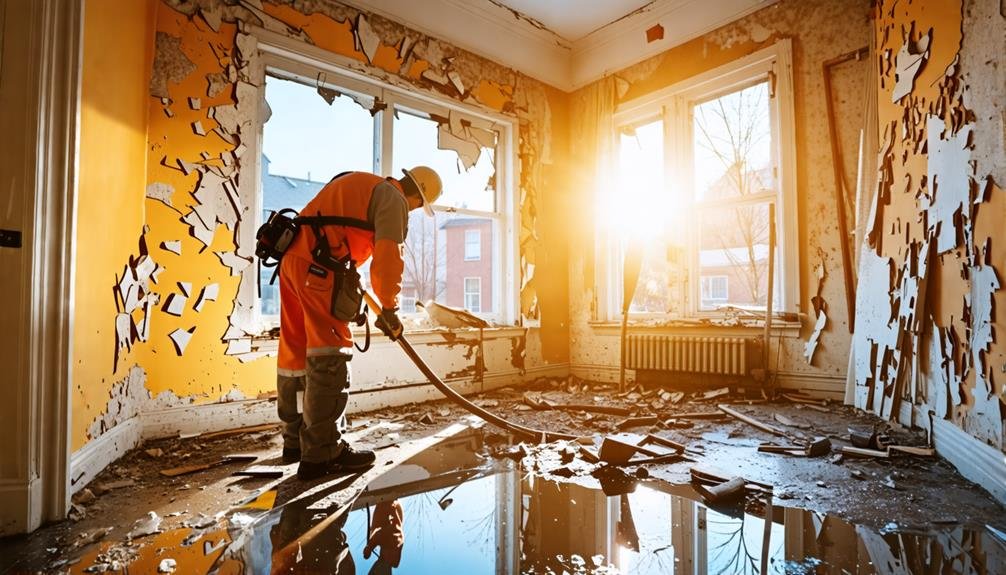
To effectively assess water damage, you must first identify the source and extent of the moisture intrusion in your property. This damage assessment is essential for determining the necessary steps to take. Here's how you can proceed:
- Locate the Water Source: Pinpoint where the water is coming from, whether it's a burst pipe, leaking roof, or an overflowing appliance. Understanding the water source helps prevent future issues.
- Examine Affected Areas: Check all impacted spaces, including walls, floors, and ceilings. Look for discoloration, warping, or soft spots, as these are indicators of hidden damage.
- Measure Moisture Levels: Use a moisture meter to assess levels in materials like wood and drywall. This data will guide you in evaluating the severity of the damage and determining what needs to be dried or replaced.
The Restoration Process
After evaluating the damage, the restoration process begins with immediate actions to mitigate further issues and restore your property to its pre-damage condition. Your restoration timeline starts with water extraction, where powerful pumps and vacuums are used to remove standing water efficiently. This step is vital to prevent mold growth and structural damage.
Next, specialized equipment is employed for drying and dehumidifying your home. High-velocity air movers and industrial dehumidifiers work together to guarantee that moisture levels are reduced to safe standards. This phase typically takes 24 to 48 hours, depending on the extent of the water damage.
Once everything is dry, the focus shifts to cleaning and sanitizing affected areas. This may involve using antimicrobial treatments to eliminate potential health hazards. Restoration may likewise include repairing or replacing damaged materials, such as drywall, flooring, and insulation.
Throughout the process, professionals keep you informed about the restoration timeline, making sure you understand each step. By utilizing advanced equipment and techniques, you can regain a safe and comfortable home while minimizing the risk of future damage.
DIY Vs. Professional Help
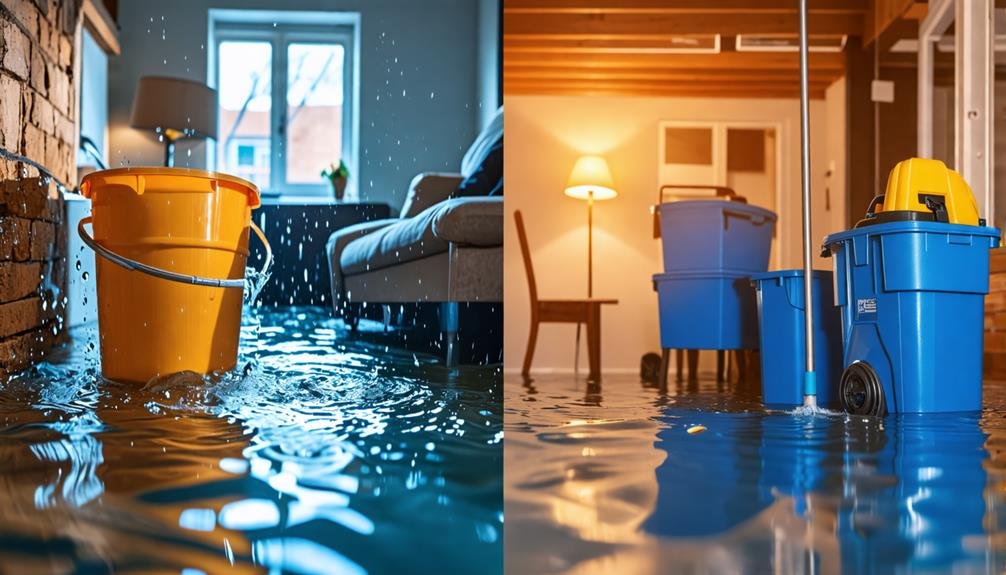
Weighing the benefits of DIY water damage restoration against hiring professionals is vital for ensuring effective recovery and preventing further complications. While DIY techniques can save you money and give you control, they often come with risks. Here are three important factors to contemplate:
- Extent of Damage: If you've got minor leaks or small areas affected, DIY methods like drying and cleaning may suffice. For extensive damage or hidden mold, professional services are key.
- Expertise and Equipment: Professionals possess specialized training and advanced equipment that most homeowners lack. Their knowledge helps identify problems you might overlook, ensuring a thorough restoration.
- Time and Efficiency: DIY restoration can be time-consuming and may lead to further damage if not handled correctly. Professionals can expedite the process, minimizing disruption to your life.
Ultimately, evaluating the severity of the damage and your comfort level with DIY techniques will guide your decision. While the independence of DIY is appealing, sometimes the expertise of professional services is what your home truly needs for effective recovery.
Preventing Future Water Damage
To prevent future water damage, you need to implement regular maintenance checks around your property. Proper drainage solutions and effective waterproofing techniques are crucial in safeguarding your home from potential leaks and flooding. By being proactive, you can greatly reduce the risk of water-related issues.
Regular Maintenance Checks
Regular maintenance checks are vital for identifying potential water damage risks before they escalate into costly repairs. By incorporating seasonal inspections and routine upkeep into your home maintenance schedule, you can considerably reduce the likelihood of future water damage.
Here are three key areas to focus on during your maintenance checks:
- Roof and Gutters: Inspect your roof for missing shingles or leaks and verify gutters are clear of debris. Clogged gutters can lead to water overflow, increasing the risk of damage to your foundation and walls.
- Plumbing System: Regularly check for leaks in pipes, faucets, and appliances. Even a small leak can lead to mold growth and structural damage over time, so addressing any issues promptly is fundamental.
- Basement and Crawl Spaces: Monitor these areas for moisture buildup or signs of leaks. Proper ventilation and waterproofing can help prevent water intrusion, safeguarding your home from damage.
Proper Drainage Solutions
Ensuring proper drainage around your home is a fundamental step in preventing future water damage, effectively complementing the regular maintenance checks you've implemented. First, assess your existing drainage systems. Make sure they're functioning well and directing water away from your foundation. Clogged gutters can lead to overflow, so clean them regularly.
Next, consider terrain grading. This involves shaping the land around your home to promote water flow away from the structure. A slope of at least 6 inches over the first 10 feet is ideal. If your yard is flat or slopes toward your home, you might need to regrade it.
You can additionally install additional drainage solutions, such as French drains or dry wells, to manage excess water. These systems collect and redirect water, keeping it from pooling near your foundation.
Waterproofing Techniques
Effective waterproofing techniques are vital for protecting your home from potential water damage and preserving its structural integrity. By implementing these strategies, you can prevent future issues and maintain a safe living environment. Here are three important waterproofing methods to take into account:
- Basement Waterproofing: Start with your basement, as it's often the most susceptible to water infiltration. Use interior and exterior drainage systems to manage excess moisture. Installing a sump pump can additionally help divert water away from your foundation.
- Exterior Sealing: Apply waterproof sealants to your home's exterior walls and foundation. This creates a barrier against water intrusion. Make certain to inspect and maintain these sealants regularly to verify their effectiveness.
- Gutter Maintenance: Regularly clean and maintain your gutters and downspouts. Ascertain they direct water away from your home's foundation. Think about installing gutter guards to minimize debris buildup.
Insurance Considerations
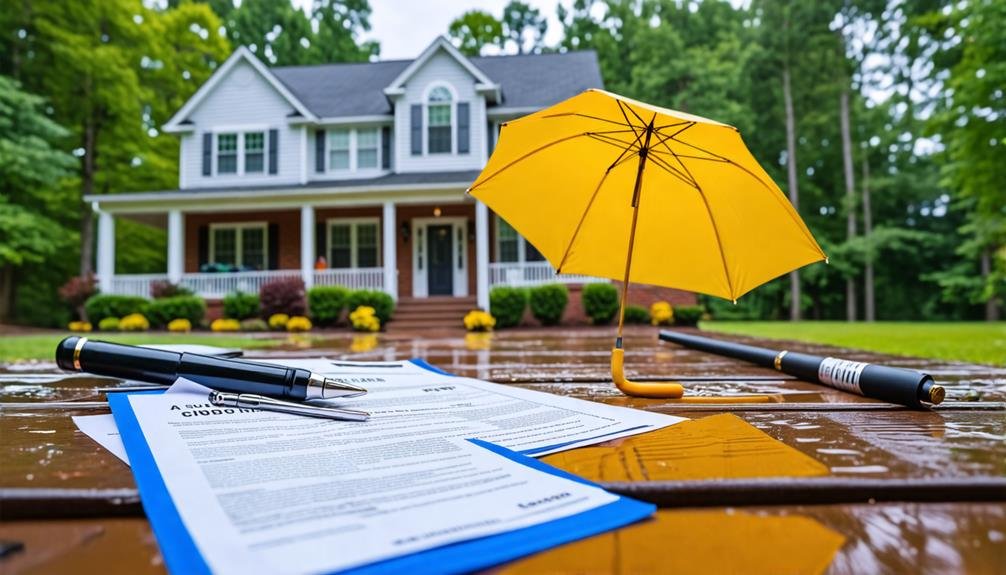
Comprehending your insurance policy's coverage for water damage is crucial to maneuvering the restoration process successfully. Many standard insurance policies cover water damage caused by sudden events, like burst pipes or storms, but not all policies include flood damage. You must review your coverage details carefully to understand what's included and what's excluded.
Once you identify your coverage, familiarize yourself with the claim process. Document the damage thoroughly by taking photos and keeping a detailed list of affected items. This documentation will support your claim and help expedite the process. Notify your insurance company as soon as possible, as there may be time limits for filing.
Be prepared to provide the required documentation and cooperate with adjusters during inspections. They'll evaluate the damage and determine the payout based on your policy's terms. If your claim is denied or you feel undercompensated, don't hesitate to appeal or seek legal advice.
Ultimately, understanding your insurance policies and the claim process can empower you to protect your home and financial wellbeing effectively. Taking these steps guarantees you're equipped to handle the aftermath of water damage.
Choosing a Restoration Company
After securing your insurance coverage, selecting the right restoration company is vital to efficiently restore your property and minimize further damage. You want a team that not only understands your needs but likewise has the expertise to handle water damage effectively. Here are three key factors to contemplate when making your choice:
- Reputation Assessment: Research potential companies through online reviews and testimonials. A strong reputation indicates reliability and quality service. Don't hesitate to ask for references from past clients.
- Experience and Qualifications: Confirm the company has certified professionals. Verify their experience in water damage restoration. A well-trained team can identify issues that less experienced companies might overlook.
- Service Guarantees: Look for companies that offer service guarantees. This shows confidence in their work and commitment to customer satisfaction. A solid guarantee can provide peace of mind and assurance that you're making a wise investment.
Maintaining a Healthy Home
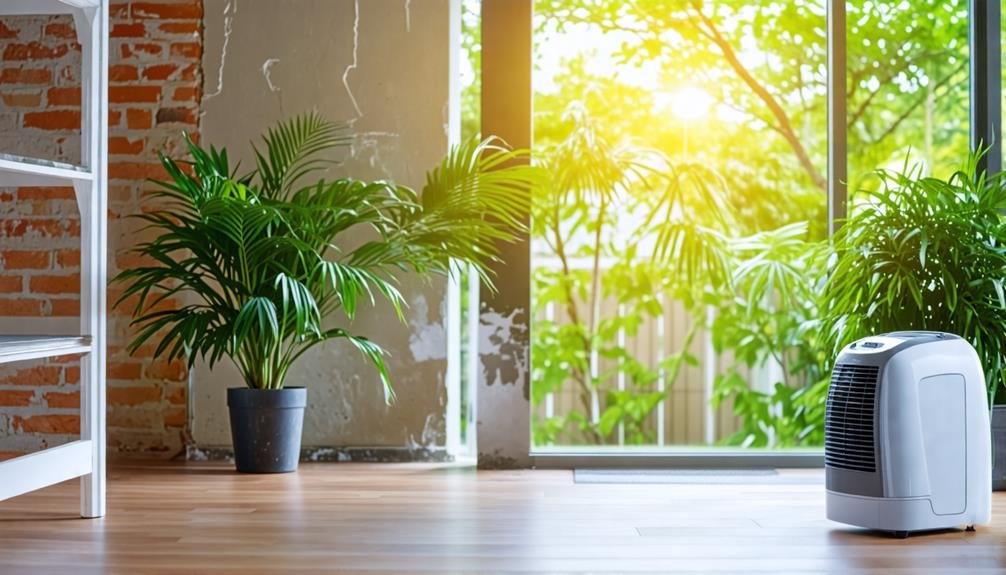
Maintaining a healthy home requires regular inspections and proactive measures to prevent issues like mold growth and structural damage. Start by checking for leaks in plumbing and roofing. Even small leaks can lead to significant water damage and mold proliferation, which can compromise your indoor air quality.
Invest in quality ventilation systems to guarantee proper airflow. Stagnant air can harbor harmful pollutants, affecting not just your health but likewise your overall sense of well-being. Using air purifiers can further improve indoor air quality, especially in high-humidity areas.
Regularly inspect and clean your HVAC system to prevent dust and allergens from circulating. Adopting a routine cleaning schedule can minimize the presence of mold spores and promote healthy living.
Don't overlook the importance of maintaining proper humidity levels. Ideally, keep indoor humidity between 30-50% to deter mold growth while guaranteeing comfort in your home.
Lastly, be vigilant about your home's exterior. Confirm proper drainage away from your foundation to prevent water accumulation, which can lead to significant structural issues. By taking these steps, you not only protect your home but likewise create a healthier living environment.
Conclusion
In the grand scheme of home ownership, water damage can feel like an unwelcome guest. By taking prompt action, evaluating the situation, and enlisting the right help, you can gently usher your home back to safety. Embracing preventive measures will keep those pesky water issues at bay, ensuring your living space remains a sanctuary. Remember, with the right knowledge and support, you can turn the tide on water damage and maintain a healthy, welcoming environment for you and your loved ones.

